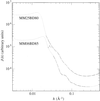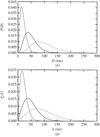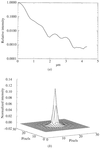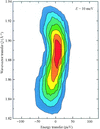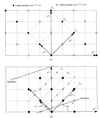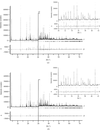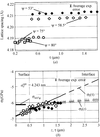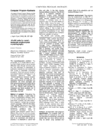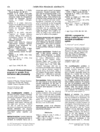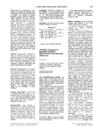issue contents
August 1999 issue

Cover illustration: Simulated diffraction pattern for a two-dimensionally disordered decasil (porous SiO2) calculated using a fast recursive algorithm. The plane is perpendicular to c with the reciprocal index l = 1; the error probability is 0.5 and the intensities are scaled to 25% of the highest value. Courtesy of Peter Daniels.
research papers
The asymptotic leading terms of small-angle scattering smeared intensities are discussed and numerically analysed. The smeared oscillatory contributions in practice coincide with those smeared by an ideal slit.
The shape and particle sizes of two triblock copolymers are obtained from the analysis of the tails of the smeared small-angle X-ray intensities. In one of the samples, particles are found to be organized as in a dense hard-sphere fluid.
This paper discusses the application of a twofold maximum entropy method for determining specimen profiles and crystallite size distributions, and their corresponding uncertainties, from size-broadened X-ray diffraction profiles. Simulated size-broadened profiles are used to demonstrate the application of the method.
Angle calculations are derived for the operation of a `4S+2D' six-circle X-ray or neutron diffractometer. Four sample-orienting and two detector-orienting degrees of freedom are used to control the scattering vector and a reference vector in the laboratory frame of reference.
Expressions are developed relating the diffraction elastic constants for a polycrystalline material to the single-crystal elastic constants for crystal systems with orthorhombic and higher symmetry. It is shown that these expressions may be used to extract single-crystal elastic constants from measurements on polycrystals or, alternatively, may be used to provide insight into the stress–strain state in polycrystalline samples by a comparison of measured and calculated diffraction elastic constants.
Mathematical formulae of the flat-specimen effect in powder diffractometry with Bragg–Brentano geometry are examined.
A unique resolution function of angular-dispersive powder diffractometers, properly parametrized to be valid for any multicrystal variant of the instrument, has been derived. A computer simulation method offers reliable information, useful for designing diffractometers and conducting experiments.
The number of independent reflections in a powder diffraction pattern is derived from the eigenvalues of the integrated intensities covariance matrix obtained from a Pawley analysis.
Procedures are described for preparing single-derivative isomorphous replacement and single-wavelength anomalous scattering difference-magnitude data for probabilistic direct-methods phasing.
A new model of line-profile broadening due to the effect of linear and planar lattice defects has been incorporated into the conventional Rietveld algorithm for the structural refinement and whole-pattern fitting of powder data. Theory is presented along with examples of applications to face-centred cubic structures.
The maximum entropy algorithm is used to deconvolute the point-spread function of two-dimensional area detectors. This results in significant image enhancement.
Simulations are presented of the dynamical diffraction of femtosecond pulses of X-rays from crystals whose structures are modified on similar time scales. Such simulations are of relevance to experiments in which short pulses of X-rays from synchrotron or laser sources are diffracted from rapidly laser-heated crystals.
Errors in the quantitative phase analysis (QPA) of α- and β-silicon nitrides (Si3N4) using the mean normalized intensity method and the Rietveld method were estimated in theory and experiments.
Two round robins of the quantitative phase analysis of silicon nitrides using the mean normalized intensity method and the Rietveld method were conducted as one of the projects for establishing standard methods of characterizing advanced ceramic materials.
This work proposes a new peak-shape function for modelling X-ray powder diffraction profiles, based on the use of the Gaussian function and a Hermite polynomials series expansion.
An experimental study on the nature of extremely narrow overlapped maxima on X-ray diffraction ω scans is presented.
Second-order aberrations in bent-crystal three-axis spectrometers have been derived and verified experimentally. Substantial improvement of resolution was achieved through control of second-order effects.
High-resolution electron-microscopy observations support the previous structural model proposed for the φ′- and δ-AlON spinel phases which allows for the double modulation of composition and displacement of the anions and cations.
The structure of sodium para-hydroxybenzoate has been solved ab initio by high-resolution X-ray powder diffraction; the quality of the powder data permits the detection of the position of the H atom connected to the phenolate. The sample shows extreme anisotropic peak broadening which could be satisfactorily modelled by a recently developed function.
The theoretical background of a new formalism in X-ray stress analysis (XSA) is derived. It allows the self-consistent evaluation of steep multiaxial residual-stress gradients in the near-surface region of polycrystalline materials from the strain data, which are measured in the scattering-vector mode of the XSA.
A newly developed formalism for the analysis of steep residual-stress gradients in the near-surface region of polycrystalline materials is applied to several practical cases. It yields the in-plane stresses, σ11(τ) and σ22(τ), the strain-free lattice spacing, d0(hkl), and, for well pronounced lattice-spacing depth profiles, even the out-of-plane stress, σ33(τ), in a self-consistent way.
Formal aspects of automatic crystal orientation determination from Kikuchi patterns are discussed. Reliability of automatically obtained results and their sensitivity to experimental errors are investigated.
It is shown how measurements using the Kα doublet influence evaluation procedures such as stripping, single-line analysis and Rietveld refinement. Moreover, a detailed description of the line-shape behaviour for different geometrical arrangements of powder diffractometers is given.
This is the first report of the application of in situ high-temperature quantitative phase analysis. The application to NiO in ceramic pigments is described.
cryocrystallography papers
A helium cryostat developed at the University of Toledo has been used to flash-cool and collect data from crystals of lysozyme and myoglobin, including flash-cooled crystals large enough for neutron diffraction purposes. The liquid-He consumption of the device is sufficiently low to allow the acquisition of complete diffraction data from a crystal on a single tank of He, and should expand He-temperature data-collection opportunities.
teaching and education
Free 

A computer program has been developed which can be used both as a teaching aid to illustrate the principles and the application of the Fourier series in crystallography, and as a research tool to permit the systematic calculation of permutation syntheses for all centrosymmetric plane groups.
short communications
A reliable and inexpensive goniometer head has been designed and a high-temperature version has been tested at 973 K on a K0.88Rb0.12TiOPO4 crystal.
computer programs
Computer modelling based on the extended learnt profile is used to refine the calculated net intensities. The user may select the learnt-profile model, from three available, in order to obtain a name.hkl file for crystal structure determination or to view the intensity plots of the measured profiles and their models.
laboratory notes
A high-temperature furnace, operating between ambient temperature and 1500 K, is described for the automatic collection of X-ray diffraction data on the Mar345 imaging-plate detector system. The complex ceramic parts were produced from presintered α-Al2O3 precompacts.
computer program abstracts
WinGX is a suite of Microsoft Windows™ programs for the processing, solution, refinement and publication of single-crystal diffraction data.
A Windows-95-based program for powder X-ray diffraction data processing, PowderX, is presented.
An update of the program DISCUS for diffuse scattering and defect structure simulations is presented.
XFPA98 is a versatile tool for direct Patterson solution and preliminary refinement of crystal structures.


 journal menu
journal menu










